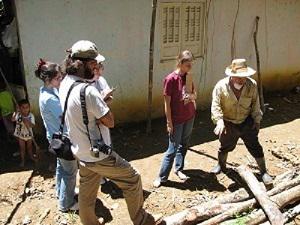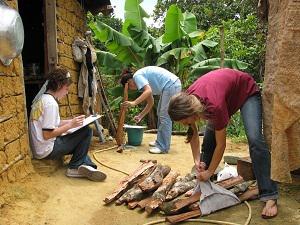Maria Joana da Silva Specht
This project aims to identify the patterns of firewood consumption by rural communities in a regional scale, identifying main areas that need more efforts on management of this resource.

My research's group (Diana Nobre, Cristiane Lucena and Felipe Lopes - the advisor) in a interview in Cabo de Santo Agostinho, Pernambuco State, Brazil. © Ivson Filho.
The Atlantic Forest actually is intensively fragmented, were only 12% of the original forest cover remains distributed in thousands of small forest fragments, embedded into a non forested matrix. However, this forest still suffers perturbations of hunting and logging by the people living in poor conditions. In this way, is very common the use of firewood by rural communities in northeast Brazil, but the data about amount and patterns of firewood use by this people are inaccurate. We wish to examine in this project the determinants factors of firewood consumption by rural communities in a broad regional scale, in a Brazil Northeast. This work will quantify the amount of biomass consumed as wood fuel as well as which tree species are more consumed and its contribution to carbon emissions. We hypothesize that socioeconomic factors like income, number of person per family added a factors of accessibility through roads, distances to nearest forest fragment, highways, urban centres and landscape forest cover, will predict the pattern of firewood consumption by the rural villages situated by the Brazil northeast. We will apply semi-structured interviews with 200 households to identify the socioeconomics conditions of these people, the preferential tree species used as firewood, the rate of firewood consumption and the use of other fuel types as well as cooking stoves characteristics.

My research's group evaluating the amount of wood fuel in a rural household in Cabo de Santo Agostinho, Pernambuco State, Brazil. © Ivson Filho
Additionally, to analyse the impact of firewood extraction on forest regeneration, we will compare richness, abundance and composition of regeneration pool (i.e. seedlings < 50 cm height) between 30 extraction sites and non-extraction sites in paired design, in the largest continuous fragment of Atlantic Forest of northeast. Also with this experiment we wish the draw conclusions about its effects on forest regeneration through forest biomass removal. Furthermore, an illustrative map will be created as a guideline for the management of firewood by local governments. By this way, we aim to provide a comprehensive tool for governmental and/or non-governmental organizations to promote sustainable used of this natural resource.